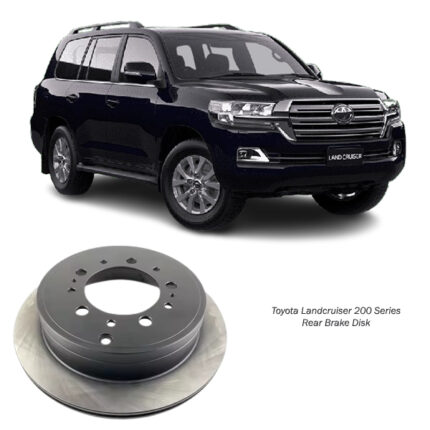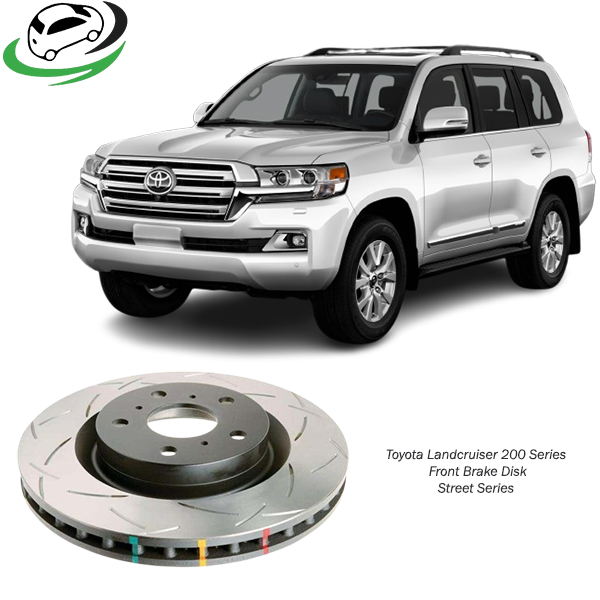-5%
Get Toyota Landcruiser 200 Series Front Brake Disk Street Series DBA42722S
A brake disc, also known as a brake rotor, is a crucial component of a vehicle’s braking system. It works in conjunction with brake pads to stop or slow down the vehicle by converting kinetic energy into heat through friction. Understanding the function, types, benefits, and maintenance of brake discs can help in maintaining optimal vehicle performance and safety.
Function of Brake Discs
The primary function of brake discs is to provide a surface for the brake pads to press against, creating the friction necessary to slow down or stop the vehicle. Here’s how the process works:
- Hydraulic Pressure: When the driver presses the brake pedal, brake fluid is forced through the brake lines to the calipers.
- Caliper Action: The calipers, which house the brake pads, then squeeze the pads against the rotating brake discs.
- Friction: The friction between the brake pads and the discs slows down the rotation of the wheels, thereby decelerating or stopping the vehicle.
- Heat Dissipation: The brake discs are designed to dissipate the heat generated during this process to prevent overheating and maintain braking efficiency.
Types of Brake Discs
Brake discs come in various designs and materials, each offering different benefits and suited to different driving conditions:
- Solid Discs: These are the simplest and most common type of brake discs. They consist of a single, solid piece of metal. Solid discs are durable and cost-effective but may not dissipate heat as efficiently as other types.
- Vented Discs: These discs have a series of internal vanes or channels between two disc surfaces, allowing for better air circulation and improved heat dissipation. Vented discs are commonly used in performance and heavy-duty applications where heat management is crucial.
- Drilled Discs: Drilled brake discs have holes drilled through them. This design helps dissipate heat and gases that can build up during heavy braking, improving performance and reducing the risk of brake fade. However, drilled discs can be more prone to cracking under extreme stress.
- Slotted Discs: Slotted discs have grooves or slots machined into the surface. These slots help to remove debris, water, and gases from the disc surface, providing better contact between the disc and the pads. Slotted discs are often used in high-performance and off-road applications.
- Drilled and Slotted Discs: Combining the features of both drilled and slotted discs, these offer enhanced cooling, debris removal, and braking performance. They are popular in high-performance vehicles and racing applications.
- Carbon-Ceramic Discs: These high-end discs are made from a composite of carbon fiber and ceramic materials. They offer superior heat resistance, reduced weight, and exceptional performance. Carbon-ceramic discs are commonly found in high-performance and luxury vehicles but are significantly more expensive.
Benefits of High-Quality Brake Discs
1. Improved Braking Performance
- Superior Friction: High-quality brake discs are made from advanced materials that offer better friction properties, ensuring more effective and consistent braking. This leads to shorter stopping distances and enhanced control over the vehicle.
- Better Heat Dissipation: Premium brake discs are designed to dissipate heat more efficiently, reducing the risk of overheating and brake fade. This is especially important during prolonged or intense braking, such as driving down steep hills or during high-speed stops.
2. Enhanced Safety
- Reliable Stopping Power: High-quality brake discs ensure that the vehicle can stop quickly and safely, significantly reducing the risk of accidents. This reliability is crucial in emergency situations where every fraction of a second counts.
- Consistent Performance: With superior materials and manufacturing processes, high-quality brake discs provide consistent braking performance across a range of driving conditions, ensuring safety in both everyday driving and extreme situations.
3. Durability and Longevity
- Wear Resistance: High-quality brake discs are made from durable materials that resist wear and tear, extending the life of the discs. This reduces the frequency of replacements and lowers long-term maintenance costs.
- Resistant to Warping and Cracking: Advanced manufacturing techniques and materials used in high-quality brake discs help them resist warping and cracking under extreme conditions, maintaining their structural integrity and performance over time.
4. Enhanced Driving Comfort
- Reduced Noise: High-quality brake discs often incorporate design features that minimize noise during braking, such as precision machining and advanced materials. This results in a quieter and more pleasant driving experience.
- Minimized Vibration: Superior brake discs reduce vibrations that can occur during braking, leading to a smoother ride and improved overall comfort.
5. Better Compatibility with Advanced Braking Systems
- Optimal Performance with ABS: High-quality brake discs are designed to work seamlessly with modern braking systems like Anti-lock Braking System (ABS), ensuring optimal performance and safety.
- Electronic Stability Control (ESC) Compatibility: These discs are also compatible with Electronic Stability Control (ESC) systems, maintaining the effectiveness of these advanced safety features.
6. Cost-Effectiveness in the Long Run
- Fewer Replacements: The increased durability of high-quality brake discs means they need to be replaced less frequently, saving money over time.
- Reduced Repair Costs: By maintaining the integrity of the braking system, high-quality discs prevent damage to other components like calipers and pads, further reducing repair costs.
7. Environmental Benefits
- Reduced Brake Dust: High-quality brake discs often produce less brake dust, which not only keeps your wheels cleaner but also reduces environmental pollution.
- Sustainable Materials: Many premium brake discs are made using more environmentally friendly materials and processes, contributing to sustainability.
8. Aesthetic Appeal
- High-Quality Finish: Premium brake discs often come with a superior finish that resists rust and corrosion, maintaining their appearance and performance over time.
- Performance Look: Many high-end brake discs have a performance-oriented design, such as drilled or slotted patterns, which can enhance the visual appeal of your vehicle.
9. Enhanced Resale Value
- Maintained Vehicle Value: Vehicles with high-quality brake components are often seen as better maintained and can fetch a higher resale value. Potential buyers are likely to appreciate the investment in superior braking components.
10. Technological Advancements
- Innovative Designs: High-quality brake discs benefit from the latest technological advancements in materials and design, providing superior performance. Innovations such as carbon-ceramic materials offer exceptional heat resistance and weight reduction, further enhancing braking performance.
- Precision Manufacturing: Advanced manufacturing processes ensure that high-quality brake discs have precise dimensions and tolerances, leading to better fitment and performance.
Maintenance and Care of Brake Discs
Proper maintenance of brake discs is essential for ensuring optimal performance and longevity. Here are some key maintenance tips:
- Regular Inspection: Periodically inspect the brake discs for signs of wear, such as grooves, cracks, or excessive thinning. Measuring the disc thickness can help determine if they need replacement.
- Brake Pad Replacement: Replace brake pads before they wear down completely to prevent damage to the brake discs. Worn pads can score and damage the disc surface.
- Cleaning: Keep the brake discs clean by removing debris and brake dust that can accumulate and affect performance. Use appropriate cleaners that do not damage the disc surface.
- Avoid Overheating: Avoid continuous heavy braking, especially on steep descents, to prevent overheating and potential warping of the discs.
- Proper Bedding: When installing new brake pads and discs, follow the manufacturer’s recommended bedding procedure to ensure optimal contact and performance.
- Fluid Maintenance: Maintain the brake fluid at the recommended level and replace it according to the manufacturer’s guidelines. Contaminated or low brake fluid can affect braking performance and damage the braking system.
Signs of Worn or Damaged Brake Discs
1. Vibration or Pulsation
- Brake Pedal Vibration: If you feel a vibrating or pulsating sensation in the brake pedal when you apply the brakes, it often indicates that the brake discs are warped or unevenly worn.
- Steering Wheel Vibration: In some cases, you might feel the vibration through the steering wheel, especially when braking from high speeds. This is a clear sign that the brake discs may be warped or damaged.
2. Noise
- Squealing or Squeaking: A high-pitched squealing or squeaking noise when braking can indicate that the brake pads are worn down and need replacement. However, if the pads are replaced and the noise persists, it could be due to worn or glazed brake discs.
- Grinding Noise: A grinding or growling noise when braking is a serious indicator that the brake pads are completely worn down, and the metal backing plate is contacting the disc. This not only damages the brake disc but also severely compromises braking performance.
3. Reduced Braking Performance
- Longer Stopping Distances: If you notice that your vehicle takes longer to stop than usual, it could be a sign of worn or damaged brake discs that are not providing adequate friction.
- Spongy Brake Pedal: A spongy or soft brake pedal feel when braking can indicate that the brake discs (along with other components like brake fluid or pads) need attention.
4. Visible Damage
- Grooves or Score Marks: Inspect the brake discs visually through the wheels or by removing the wheel. If you see deep grooves, score marks, or uneven wear patterns on the surface of the disc, it’s a sign that they are worn out and need resurfacing or replacement.
- Cracks: Any visible cracks on the brake disc surface indicate severe wear or damage and necessitate immediate replacement to avoid brake failure.
5. Thickness Variation
- Disc Thickness Variation (DTV): This occurs when there is an uneven thickness across the surface of the brake disc, often leading to vibration and pulsation during braking. It can be measured using a micrometer to determine if the disc is within the manufacturer’s specified tolerance.
- Minimum Thickness: Brake discs have a minimum thickness specification. If the disc is worn down to or below this limit, it must be replaced. This specification is usually stamped on the disc itself or available in the vehicle’s service manual.
6. Burning Smell
- Overheating: A sharp, burning chemical smell after braking hard or driving down a steep descent indicates that the brakes are overheating. This can cause the brake discs to warp and lose effectiveness.
7. Brake Fade
- Loss of Braking Power: If you experience a loss of braking power after continuous or heavy braking, it may be due to brake fade. This is often caused by overheating brake discs that cannot dissipate heat effectively.
8. Dashboard Warning Lights
- Brake System Warning Light: Many modern vehicles are equipped with sensors that can detect issues within the braking system, including the brake discs. If the brake warning light on your dashboard illuminates, it’s essential to have your brakes inspected as soon as possible.
9. Uneven Brake Pad Wear
- Uneven Pad Wear: Inspect the brake pads for uneven wear patterns. If one side of the pad is significantly more worn than the other, it could indicate that the brake disc is unevenly worn or that there is an issue with the brake caliper.
10. Pulling to One Side
- Vehicle Pulling: If your vehicle pulls to one side when braking, it could be due to uneven wear on the brake discs or a problem with the brake calipers. This can lead to uneven braking force being applied to the wheels.
Follow us on Facebook for more parts.



